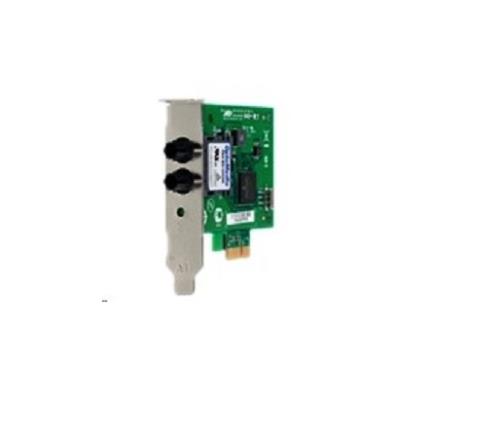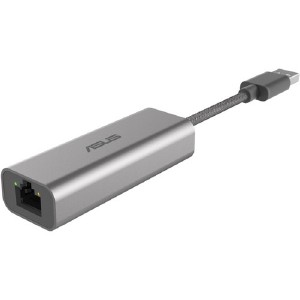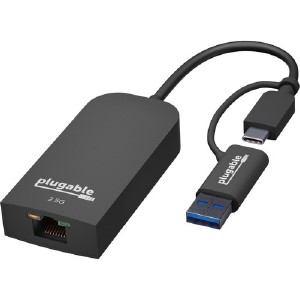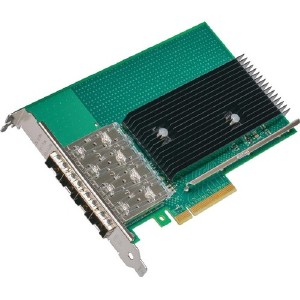Allied Telesis 1000SX ST PCI Express x1 Adapter Card - PCI Express 2.0 - 1 Port(s) - 1 x ST Port(s) - Optical Fiber - 1000Base-SX - Plug-in Card AT-2911SX/ST-901
AT-2911SX/ST-901 | Allied Telesis®
Part Number: AT-2911SX/ST-901
Condition: New
In Stock: 3
Real time availability 
Product Specifications
Allied Telesis 1000SX ST PCI Express x1 Adapter Card - PCI Express 2.0 - 1 Port(s) - 1 x ST Port(s) - Optical Fiber - 1000Base-SX - Plug-in Card AT-2911SX/ST-901
FED COMP 32/64 BIT PCI EXPRESS - ADAPTER CARD ST CONNECTOR
Manufacturer Part Number: AT-2911SX/ST-901
Note:
- The full product specifications below are from the manufacturer and may contain information related to other package quantities that will not apply to the product that you are reviewing. Please confirm the actual content and/or package quantity from the main product specifications page.
- These specifications may represent the entire product series/model/line to which this product belongs with specific configuration differences between the individual products stated.
- These specifications may have been copied from the same product in other region/country in which case there might be minor differences in region-specific data such as Input Voltage, Terms of Warranty etc.
Specifications
Management Features
- Windows Management Instrumentation (WMI)
- P X E 2.1
- SNMP
- PCI Express v2.0
Bus Type
- PCIe x1
Ethernet
- IEEE 802.1p: Quality of Service
- IEEE 802.1Q: VLANs
- IEEE 802.2: LLC
- IEEE 802.3ac: MAC
- IEEE 802.3az: Energy-Efficient Ethernet
- IEEE 802.3x: Flow control auto-negotiation
- IEEE 802.3z: 1000 Base-X
- IEEE 802.3ad: Link aggregation
- IEEE 802.3ab: 10/100/1000T
Drivers
- Windows 10, 64- or 32-bit
- Windows 8, 64- or 32-bit
- Windows 7, 64- or 32-bit
- Windows Vista, 64- or 32-bit
- Windows XP, 64- or 32-bit
- Windows Server 2012 R2, 64-bit
- Windows Server 2012, 64-bit
- Windows Server 2008 R2, 64- or 32-bit
- Windows Server 2008, 64- or 32-bit
- Windows Server 2003, 64- or 32-bit
- Linux 2.6
Interface Type and Connectors
- 1000SX/ST connector
- Optical sensitivity: -17 dBm
- Output optical power: -9.5/-4 dBm
- Wavelength: 850 nm
- 1000SX/SC connector
- Optical sensitivity: -17 dBm
- Output optical power: -9.5/-4 dBm
- Wavelength:850 nm
- 1000SX/LC connector
- Optical sensitivity: -17 dBm
- Output optical power: -9.5/-4 dBm
- Wavelength: 850 nm
- 1000LX/SC connector
- Optical sensitivity: -20 dBm
- Output optical power: -9/-3 dBm
- Wavelength: 1310 nm
- 1000LX/LC connector
- Optical sensitivity: -20 dBm
- Output optical power: -9/-4 dBm
- Wavelength: 1310 nm
Status Indicators
- LED
- On: Link up
- Off: Link down
- Blinking: Activity
Power
- Power consumption: 1.51 to 2.42W (varies by model)
- Signaling voltage: 3.3V
Environmental Specifications
- Operating temperature: 0ºC to 40ºC (32°F to 104°F)
- Relative humidity: 5% to 90% (non-condensing)
- Storage temperature: -25ºC to 70ºC (-13°F to 158°F)
- Dimensions (W x H): 8.8 cm x 6.9 cm (3.5 in x 2.7 in)
- Weight: .068 kg (.13 lb)
Compliance
- RoHS
- UL
- FCC/EN55022 Class A
- TUV
- EN55024
- CE
- C-TICK
- VCCI
MANUFACTURER NAME: Allied Telesis
MANUFACTURER PART NUMBER: AT-2911SX/ST-901
UPC EAN CODE: 767035206479
LANGUAGE: EN
MARKET:US
| General Information: | |
Allied Telesis 2911 Series Network Interface Cards feature a PCI Express (PCIe x1) design, providing the maximum possible bandwidth and bus efficiency while providing the benefits of low power consumption. | |
| Manufacturer | Allied Telesis, Inc |
| Manufacturer Part Number | AT-2911SX/ST-901 |
| Manufacturer Website Address | http://www.alliedtelesis.com |
| Brand Name | Allied Telesis |
| Product Series | AT-2911 |
| Product Model | AT-2911SX/ST-901 |
| Product Name | 1000SX ST PCI Express x1 Adapter Card |
| Product Type | Gigabit Ethernet Card |
| Product UPC | 767035206479 |
| Interfaces/Ports: | |
| Host Interface | PCI Express 2.0 |
| Total Number of Ports | 1 |
| Number of ST Ports | 1 |
| Media & Performance: | |
| Media Type Supported | Optical Fiber |
| Network & Communication: | |
| Network Technology | 1000Base-SX |
| Physical Characteristics: | |
| Form Factor | Plug-in Card |
| Width | 3.5" |
| Depth | 2.7" |
| Weight (Approximate) | 2.08 oz |
| Miscellaneous: | |
| What's in the box |
|
| Environmentally Friendly | Yes |
| Country of Origin | Singapore |
Questions and Answers
Questions and Answers | Ask CompSource |
Shipping / Returns
Shipping
Ground =
$12.95
(EST. Arrival Date between
Thu.Nov.28 - Tue.Dec.3)
Two Day Air = $25.00
(EST. Arrival Date on Thu.Nov.28)
Standard One Day = $35.00
(EST. Arrival Date on Wed.Nov.27 after 3PM)
Priority = $45.00
(EST. arrival Date on Wed.Nov.27 in the AM)
U.S Mail Priority (AA,AE,AP only) = $30.00
FedEx International Economy (Canada only) = $85.00
Shipping dates are best estimates based on product location and may vary with holidays.
If product requires trucking, additional fees may apply.
* Some destinations are subject to Applicable State/Duty Taxes
Returns
CompSource realizes that every product may have different return guidelines. Please see the policy below regarding this item.
This Product Has Limited Exchange Privileges.
Please call for return guidelines.
For support on this product, please contact Allied Telesis. 1.800.424.6596 WWW.ALLIEDTELESIS.COM
Allied Telesis Company's Information
Click Allied Telesis for all products
Local #: (425)481-3714
Toll Free #: 1.800.424.6596
Site: WWW.ALLIEDTELESIS.COM
Product Reviews
Overall Rating | Write a Review
|
|
Best Sellers
More Best Sellers
Learn more about Network Cards
Switches, routers, and wireless access points
Switches, routers, and wireless access points perform very different functions in a network.
A computer network, or data network, is a digital telecommunications network which allows nodes to share resources. In computer networks, computing devices exchange data with each other using connections (data links) between nodes These data links are established over cable media such as wires or optic cables, or wireless media such as WiFi.Switches
Switches are the foundation of most business networks. A switch acts as a controller, connecting computers, printers, and servers to a network in a building or a campus.
Switches allow devices on your network to communicate with each other, as well as with other networks, creating a network of shared resources. Through information sharing and resource allocation, switches save money and increase productivity.
There are two basic types of switches to choose from as part of your networking basics: managed and unmanaged.
- An unmanaged switch works out of the box but can't be configured. Home-networking equipment typically offers unmanaged switches.
- A managed switch can be configured. You can monitor and adjust a managed switch locally or remotely, giving you greater control over network traffic and access.
Routers
Routers connect multiple networks together. They also connect computers on those networks to the Internet. Routers enable all networked computers to share a single Internet connection, which saves money.
A router acts a dispatcher. It analyzes data being sent across a network, chooses the best route for data to travel, and sends it on its way.
Routers connect your business to the world, protect information from security threats, and can even decide which computers receive priority over others.
Beyond those basic networking functions, routers come with additional features to make networking easier or more secure. Depending on your needs, for example, you can choose a router with a firewall, a virtual private network (VPN), or an Internet Protocol (IP) communications system.
Access points
An access point* allows devices to connect to the wireless network without cables. A wireless network makes it easy to bring new devices online and provides flexible support to mobile workers.
An access point acts like an amplifier for your network. While a router provides the bandwidth, an access point extends that bandwidth so that the network can support many devices, and those devices can access the network from farther away.
But an access point does more than simply extend Wi-Fi. It can also give useful data about the devices on the network, provide proactive security, and serve many other practical purposes.
*Access points support different IEEE standards. Each standard is an amendment that was ratified over time. The standards operate on varying frequencies, deliver different bandwidth, and support different numbers of channels.
Wireless networking
Wireless networking is a method by which homes, telecommunications networks and business installations avoid the costly process of introducing cables into a building, or as a connection between various equipment locations.CompSource will educate and help make this process enjoyable and easy.
Whether you're planning on using your network for basic home tasks or enterprise level security. You can tell our trained sales professionals your needs, and we�ll make custom recommendations to suit your specifications and budget. Our reps have extensive knowledge and love to share. We educate, not sell, CompSource makes sure you buy what you need and not waste money on what you don't. As with every decision we never push, it's up to you when, and if you make a purchase.
CompSource has a great technical staff that can help with a solution for your exact needs.
Chat with us or give our professionals a quick phone call (800)-413-7361.
I've purchased from CompSource in the past and was thoroughly please with all aspects of ordering process, but especially with the care that was taken in the packing of my order! icee2000More Reviews





















